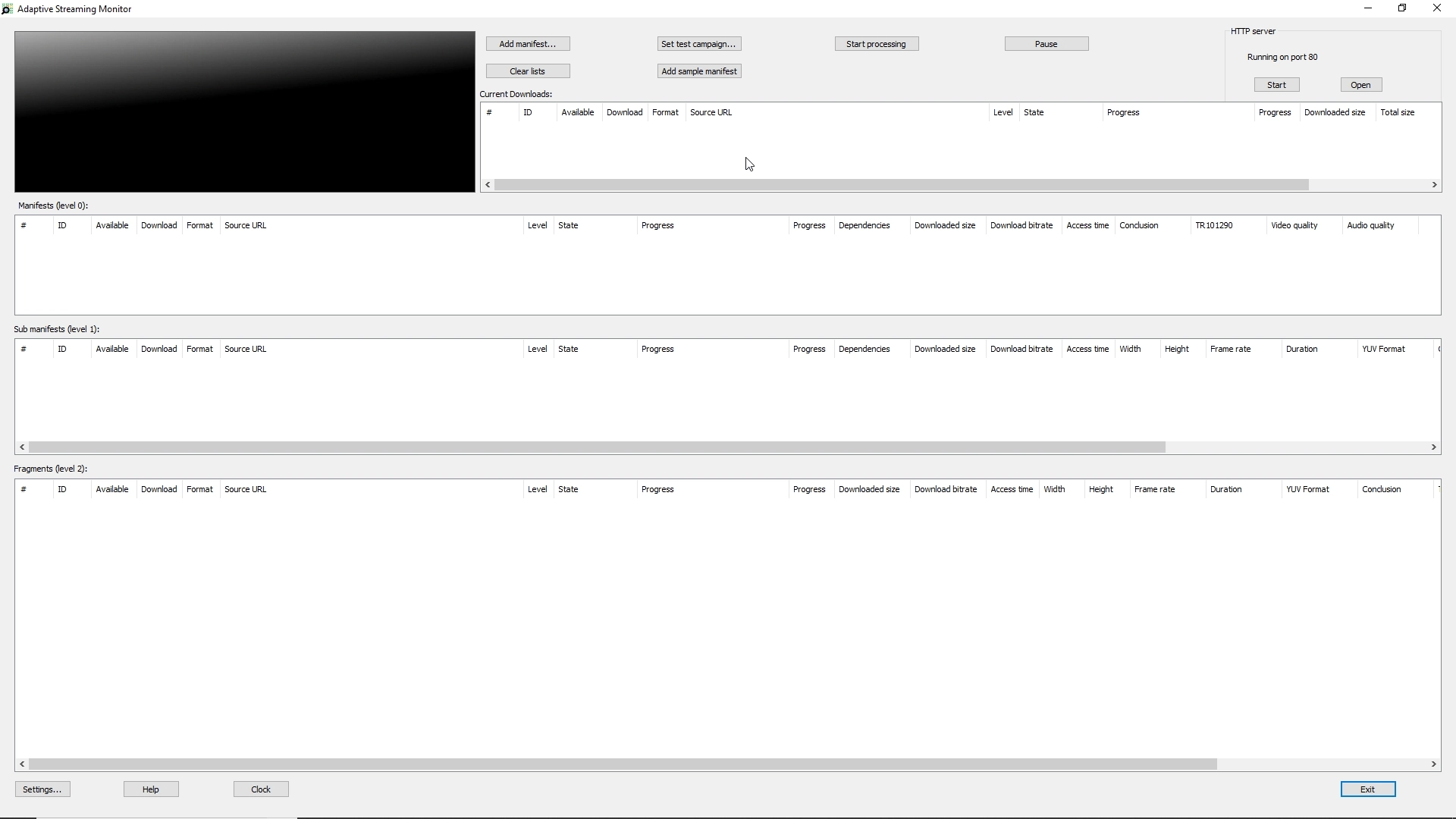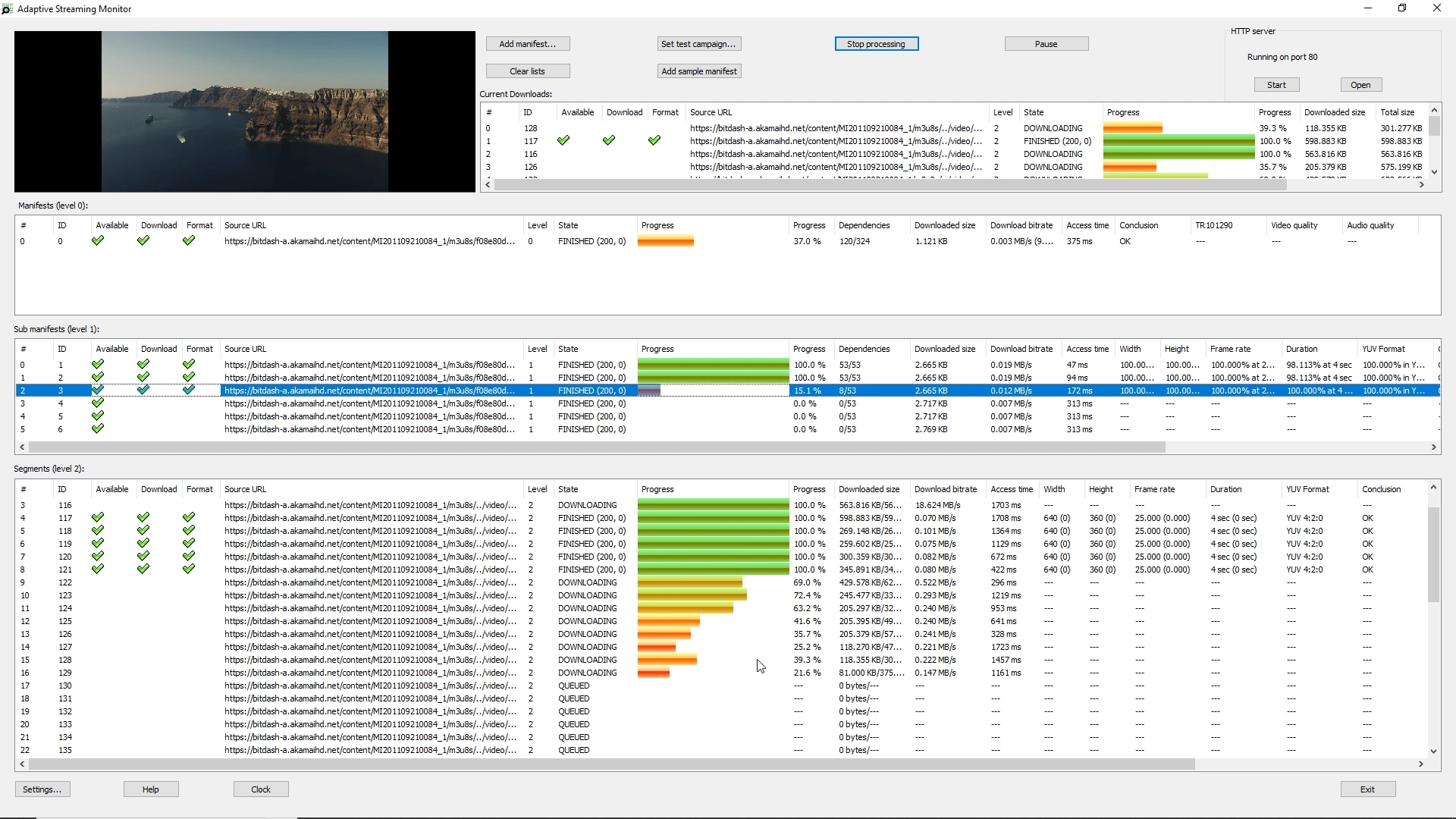Adaptive Streaming Monitor
QoE and QoS monitoring for HLS and MPEG DASH streams.
Monitor video quality and audio quality. Detect TR 101 290 errors, present/missing fragments, their resolutions, frame rates, durations, YUV formats... and more!
Get alerts and reports if problems are detected on your HLS and MPEG DASH streams.
- Visually, how does your 1080p streaming compare to your 720p streaming?
- Are all the video segments of your 4K streaming available?
- Do they all have a standards-compliant bitstream?
Adaptive Streaming Monitor (ASM) is a complete solution to measure and monitor the QoE (Quality of Experience) and QoS (Quality of Service) of your HLS and MPEG DASH streams.
ASM produces perceived video quality scores expressed on a MOS (Mean Opinion Score) scale. ASM's perceived video quality metrics are dedicated to HEVC (H.265), MPEG-4/AVC (H.264) and MPEG-2 video encoding formats. These video quality metrics have been optimized to produce quality scores which are highly correlated with human jugdments collected during subjective quality assessment tests in normalized conditions (ITU BT.500 and ITU BT.710).
ASM enables to:
- check the presence of all the manifests and segments of HLS and MPEG DASH streams
- measure the video quality (MOS) of every audio/video segment
- measure the audio quality (MOS) of every audio/video segment
- measure TR 101 290 errors on every transport stream
- check the stability of resolution, frame rate, duration and YUV format on all the segments of any profile
- receive alerts if problems are detected
ASM can process HLS and MPEG DASH streams on both HTTP and HTTPS servers.
Concerning MPEG DASH: for now, ASM supports the 8 first description types given by the DASH Industry Forum on this page: http://testassets.dashif.org/#testvector/list. Support for additional types of descriptions is under development.
Starting Adaptive Streaming Monitor
At start up, ASM displays a window which enables to enter the URLs of HLS and MPEG DASH streams to monitor.
Simply enter one or several URLs and click a button. ASM will download each HLS and MPEG DASH manifest and all the specified video segments.
During processing, ASM displays the currently downloaded files and the status of each processed manifest or video segment: download bitrate, access time, resolution, duration, frame rate, YUV format, detected TR 101 290 errors, video quality and audio quality.
Checking and monitoring
Each downloaded video segment is:
- parsed to find its video resolution (width and height), frame rate, duration and YUV format
- decoded to be displayed and to measure video quality using the same video quality metrics as Video Quality Monitor
- decoded to measure audio quality using the same audio quality metric as Video Quality Monitor
- checked for transport streams errors according to the TR 101 290 recommendation
Each time a video segment is processed, its measures are propagated to its parent manifest. This enables you to get statistics, for example to know:
Results and alerts
For each video segment, the following values are measured:
- file presence
- download bitrate (and target bitrate if available)
- detected video frame width (and target video frame width if available)
- detected video frame height (and target video frame height if available)
- detected video frame frame rate (and target video frame rate if available)
- detected video frame duration (and target video duration if available)
- detected video YUV format (and target YUV format if available)
- detected TR 101 290 errors
- video quality score (expressed on a MOS scale)
- audio quality score (expressed on a MOS scale)
For each profile, the following values are measured:
- presence of all segments
- stability of video frame width
- stability of video frame height
- stability of video frame rate
- stability of video frame duration
- stability of video YUV format
- detected TR 101 290 errors for all segments
- mean video quality score (expressed on a MOS scale) over all segments
- mean audio quality score (expressed on a MOS scale) over all segments
Based on these measures, ASM can trigger alerts by email or SNMP if problems happen.
Web server
In the background, ASM permanently saves its measures in order to be able to generate monitoring reports. These reports are available in ASM's web interface.
Indeed, ASM includes its own web server. There is no need to install a separate server (like Apache): ASM's web server is already fully included in the application.
This web server enables you to connect from anywhere and get the measurement reports (available in HTML and CSV formats) and quality curves along time. You can even get the quality curves of several encoding profiles on the same graph.
Conclusion
Adaptive Streaming Monitor is an easy and powerful solution to:
- monitor HLS and MPEG DASH streams (all the profiles, all the video segments)
- measure video quality and audio quality of HLS and MPEG DASH streams
- measure TR 101 290 errors of Transports Streams
- receive alerts when problems are detected





